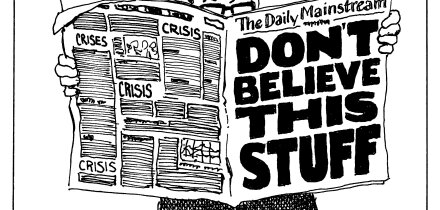Capital Structure Theory
The Modigliani and Miller (M&M) theorem on capital structure is among the most important contributions to the theory of corporate finance. In modern terms, the theorem says that the choice between debt and equity financing is irrelevant in a perfect world and firm's value is equal to the present value of the free cash flow discounted at the relevant cost of capital.
We, of course, are not in a perfect world, which means that we must take into account tax and bankruptcy costs and benefits. For corporations paying U.S. income taxes, debt has a tax advantage over equity because interest paid on debt is tax deductible while dividends paid on stock are not. Thus, income used to pay dividends is taxed twice (first at the corporate level and then at the shareholder level), but income used to pay interest is taxed only once (at the debt-holder level). This "tax shield" from debt has a cost, however. Higher leverage brings with it a greater risk of bankruptcy for the firm because the obligation to make fixed payments remains even when earnings drop.
Therefore, the so-called trade-off theory says that each company has an optimal debt-equity ratio, which is determined by trading off the benefits of debt against its costs. A corporate CFO's task, then, is to continuously balance the tax benefits of higher leverage and the greater probability of financial distress based on the corporation's specific financial status. The optimal debt ratio is one where the difference between the tax benefits and the expected bankruptcy cost is maximized (as shown below):
Value of Levered Firm = Value of All-Equity Firm + PV of Tax Benefits PV Costs of Financial Distress
But this is not the whole story. Firms may or may not have other ways of reducing their taxes, such as net operating losses or high depreciation deductions. The more non-debt tax shields a firm has, the less valuable is the tax benefit associated with issuing debt. Furthermore, the tax picture from the investors' side is different: debt is tax-disadvantaged while equity is tax-beneficial. For investors, interest is generally taxed at high ordinary income rates while dividends are either taxed at a reduced rate (if received by individuals) or are subject to a dividends received deduction (if received by corporations).
Thus, theoretically, investors should bid up equity prices (reducing equity returns) until marginal after-tax returns from debt and equity become equal on a risk-adjusted basis. In other words, while debt bears a high explicit tax, equity bears both a lower explicit tax and an additional implicit tax that in sum should be equal to the explicit tax on debt, at least in theory. If equity is cheaper to issue (i.e., if issuers capture at least a portion of the implicit tax paid by equity investors), tax benefits of debt may not be that attractive. Unfortunately, no one knows how high the implicit tax really is. One reason the analysis is complicated is that various potential investors have different marginal tax rates, depending on whether they are individuals, corporations, tax-exempt organizations or foreign entities.
Structured Products In Capital Structure
In M&M theory, the only choice is between financing with straight debt (i.e., current interest-paying fixed obligations issued at par) and straight equity (i.e., dividend-paying common stock). In modern capital markets there is a variety of structured products that offer corporate managers an alternative that may add value to their firms. Zero-coupon bonds, trust-preferred securities, and several types of convertible bonds (such as straight, zero coupon and the so-called contingent convertibles) are just some examples. Why could these instruments benefit a firm under the corporate finance theory?
First, innovative instruments give corporate issuers more choices in balancing tax benefits and bankruptcy costs. Each structured product represents a unique combination of these costs and benefits, providing firm managers with an increased flexibility in achieving just the right mix. For example, zero-coupon bonds retain the advantage of interest deductibility (unless the discount is too deep and the maturity is too long), but may reduce bankruptcy costs because they do not create a burden on the firm's cash flows until maturity. A straight convertible bond has a different trade-off. Because of the embedded conversion option, a coupon on a convertible bond is generally smaller than a coupon on a similar straight bond. This lower coupon results in a smaller tax deduction--a relative disadvantage. The company, however, benefits from increased flexibility because the lower coupon reduces the insolvency threat.
Contingent convertible bonds--a fairly recent addition to the menu of structured products--provide an even more attractive combination. Similar to a straight convertible, the coupon is relatively low, making it a cheap debt instrument in difficult times. Yet the tax deduction is high (higher than the coupon that is actually paid and equal to a coupon that would have been paid on an otherwise similar straight debt that doesn't have the contingency or the conversion option--the so-called comparable yield), largely preserving the tax benefit of straight debt.
Second, a greater variety of potential means of financing gives a firm a greater access to capital markets. Different products become particularly desirable during different times and by different groups of investors. For example, convertible bonds have been popular in the recent years, due in part to a heightened interest in this structured product from hedge funds. Over time, this means that even when straight debt or equity are not particularly well received by the markets, firms may offer other instruments in order to maintain or adjust their mixture of tax benefits and bankruptcy costs.
Finally, the uncertainty regarding implicit taxes borne by straight equity is caused at least in part by the difficulty of comparing it to straight debt on a risk-adjusted basis. Structured products are complicated financial instruments, making comparisons even more difficult. Issuers may seek to benefit from these difficulties if they believe that implicit tax borne by a particular structured product is relatively high, and the return demanded by the market is relatively low.
Conclusion
Traditional corporate finance theory sought to find the appropriate tradeoff between straight debt and straight equity financing. Debt tax shield is valuable, but it's limited by bankruptcy concerns and availability of non-debt tax shields. Structured products are a valuable addition to the corporate balance sheet. They give managers more ways of achieving the desired balance between tax benefits and bankruptcy costs. They provide firms with a greater flexibility in adjusting this balance through a continuing access to capital markets. Finally, structured products may add value to firms if they allow issuers to pay relatively low after-tax return on a risk-adjusted basis.
This week's Learning Cure was written by Winston Ma CFA, an associate in the equity derivatives products and solutions group at JPMorgan in New York, and Alex Raskolnikov, associate professor at the Columbia University School of Law.





